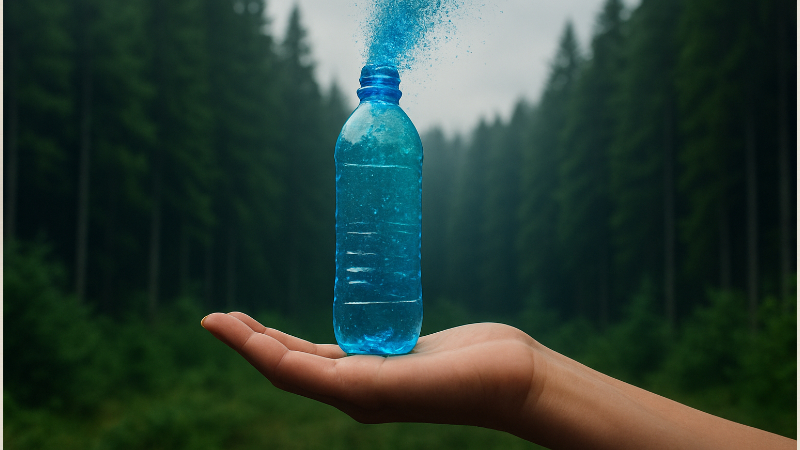AUTHORS
Siracusa, C., Manfroni, M., Coatti, A., Quartinello, F., Soccio, M., Lotti, N., Guebitz, G. M., & Pellis, A.
The escalating plastic waste crisis demands sustainable solutions, particularly for packaging. This research investigates the enzymatic degradation of next-generation bio-based plastics, poly(butylene succinate) (PBS) and poly(pentamethylene 2,5-furanoate) (PPeF). Scientists explored how these polymers, their physical blends, and block copolymers decompose using *Humicola insolens* cutinase, a specific enzyme. The study revealed significant differences: pure PBS and physical blends degraded completely and faster than PPeF and their block copolymers. This distinct behavior, influenced by the material’s internal structure and enzyme accessibility, offers crucial insights. Understanding these mechanisms is vital for developing efficient, enzyme-based recycling processes that can recover valuable polymer building blocks, thereby promoting a circular economy and reducing environmental impact from plastic waste.
The global challenge of plastic waste, particularly from packaging, urgently calls for innovative and sustainable solutions. Traditional plastics often end up in landfills or pollute our environment, driving the search for materials that are not only high-performing but also environmentally friendly and recyclable. This is where bio-based polymers, derived from renewable resources, come into play.
Among the most promising candidates are poly(butylene succinate), or PBS, known for its good flexibility, and poly(pentamethylene 2,5-furanoate), or PPeF, which offers exceptional gas barrier properties and mechanical responses akin to an elastomer. These polymers hold immense potential for diverse applications, especially in food packaging, where different mechanical properties are crucial. However, for a truly circular economy, it is essential to understand how these materials can be efficiently broken down and their components reused.
Unraveling degradation mechanisms with enzymes
A collaborative team of researchers, including Dr. Chiara Siracusa, Felice Quartinello, Prof. Georg M. Guebitz, and Prof. Alessandro Pellis from Austrian institutions (acib GmbH and the University of Natural Resources and Life Sciences, BOKU-University) and Italian partners (University of Bologna and University of Genova), recently published their groundbreaking findings in the esteemed journal Polymer Degradation and Stability. Their work provides a mechanistic study into the enzymatic hydrolysis of PBS, PPeF, and their various combinations.
The scientists focused on how a specific enzyme, Humicola insolens cutinase (HiC) – a specialized protein that can effectively break down polyester bonds – interacts with different forms of these polymers: pure PBS, pure PPeF, a physical blend of the two, and a block copolymer where the two polymers are chemically linked. Understanding these interactions is key to developing “green recycling” strategies.
Key discoveries: structure dictates degradation
The study revealed crucial differences in how these materials degrade. All tested polymer formulations achieved 100% weight loss within just 24 hours when exposed to Humicola insolens cutinase, even at low enzyme concentrations. This demonstrates the strong potential of enzymatic depolymerization for these bio-based plastics.
However, the speed and mechanism of degradation varied significantly depending on the polymer’s structure:
- Pure PBS was hydrolyzed faster than pure PPeF. PBS contains aliphatic ester bonds, which the enzyme preferentially cleaves.
- Interestingly, the physical blend of PBS and PPeF degraded more readily than the block copolymer. This is a critical finding. The researchers explained that in the physical blend, PBS and PPeF form distinct microdomains with interfaces that are more accessible to the enzyme. In contrast, the block copolymer has a more homogeneous, tightly packed microstructure, making it more recalcitrant to enzymatic attack.
Advanced analytical techniques, including Gel Permeation Chromatography (GPC), Fourier Transform Infrared Spectroscopy (FT-IR), and Nuclear Magnetic Resonance (NMR) spectroscopy, confirmed these mechanistic insights. They showed that the physical blend exhibited faster reduction in molecular weight and quicker appearance of hydrolysis-related groups compared to the copolymer, especially in the initial phases of degradation. The enzyme showed a clear preference for breaking down the aliphatic PBS components.
Pathways to a sustainable future: applications and valorization
These findings have profound implications for the design and recycling of future plastic materials. By understanding how polymer structure influences enzymatic degradation, scientists can tailor the biodegradability of new bio-based plastics. This knowledge allows for the development of materials that can be broken down efficiently into their original building blocks (monomers), which can then be recovered and reused to produce new polymers – a process known as enzymatic recycling or depolymerization. This high-quality recycling method avoids downcycling and maintains the value of the raw materials, moving us closer to a truly circular economy.
This research lays the foundation for future innovations in sustainable packaging, allowing for materials that combine excellent performance with a clear end-of-life solution. It offers a pathway to reduce plastic pollution and decrease our reliance on fossil resources, by transforming plastic waste into valuable raw materials.
Austrian excellence in green technology
This cutting-edge research, partly funded by the European Union’s Horizon 2020 program under grant agreement No 953073 and the project UPLIFT (sUstainable PLastIcs for the Food and drink packaging indusTry), significantly highlights Austria’s strong commitment and expertise in sustainable technologies and green chemistry. The substantial contributions from Austrian research institutions, namely acib GmbH and the University of Natural Resources and Life Sciences (BOKU-University) in Tulln and Vienna, underscore Austria’s role as a key player in the international scientific community for bio-based materials and enzymatic recycling. By fostering such innovative research, Austria not only strengthens its position in global scientific competition but also contributes directly to addressing pressing environmental challenges, driving economic benefits through new recycling industries, and securing a more sustainable future for all. The ability to valorize plastic waste into its constituent monomers is a crucial step towards a resilient, resource-efficient economy.
